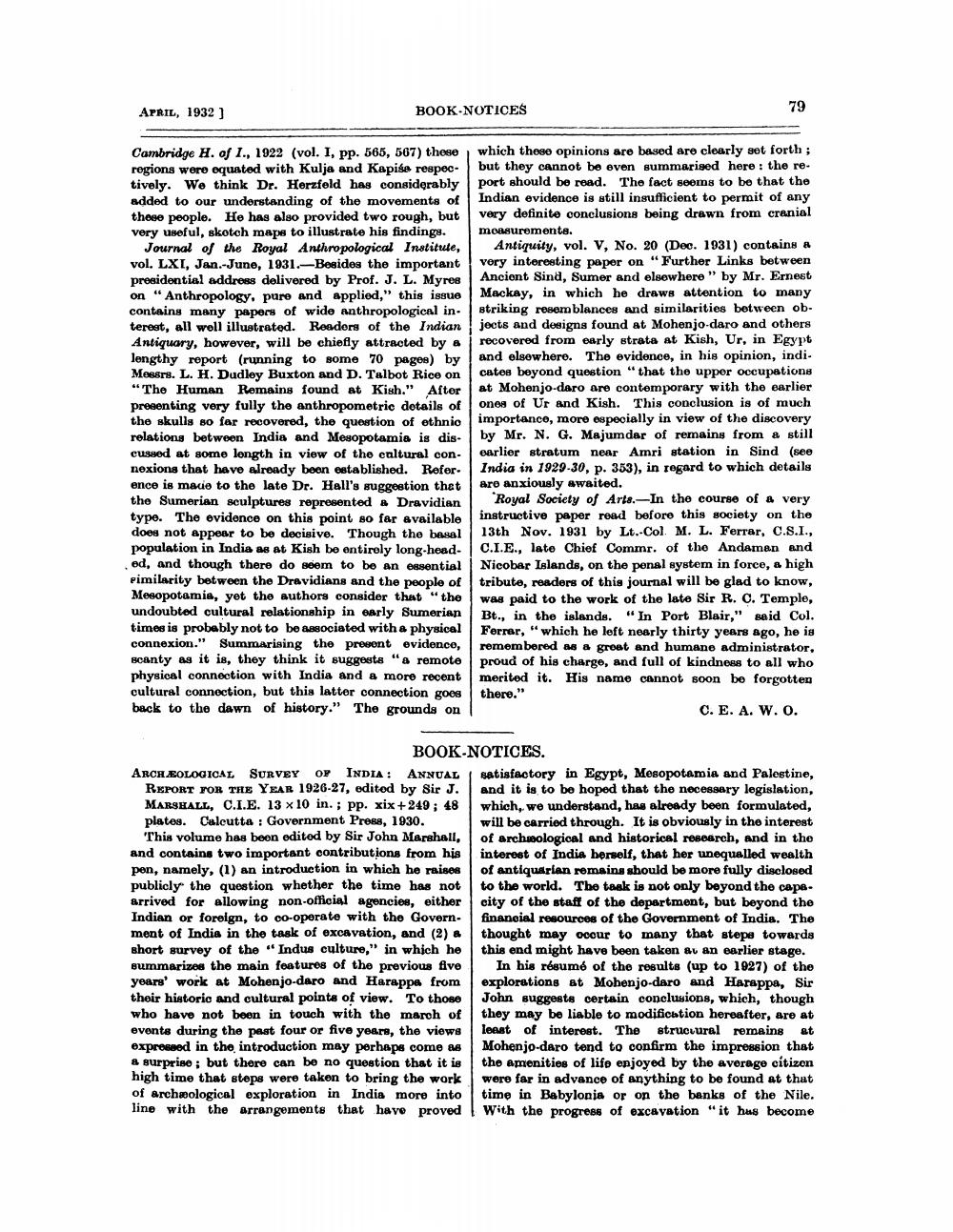________________
APRIL, 1932)
BOOK-NOTICES
79
in
Cambridge H. of I., 1922 (vol. I, pp. 565, 507) those which these opinions are based are clearly set forth; regions were equated with Kulja and Kapise respec- but they cannot be even summarised here : the re. tively. We think Dr. Herzfold has considerably port should be road. The fact seems to be that the added to our understanding of the movements of Indian evidence is still insufficient to permit of any those people. He has also provided two rough, but very definito conclusions being drawn from cranial very useful, skotch maps to illustrate his findings. moasurements.
Journal of the Royal Anthropological Institute, Antiquity, vol. V, No. 20 (Dec. 1931) contains & vol. LXI, Jan.-June, 1931.-Besides the important vory interesting paper on “Further Links between presidential address delivered by Prof. J. L. Myres Anciont Sind, Sumer and elsewhere" by Mr. Ernest on "Anthropology, pure and applied," this issue Mackay, in which he draws attention to many contains many papers of wide anthropological in. striking resemblances and similarities between obtereat, all well illustrated. Readers of the Indian jects and designs found at Mohenjo-daro and others Antiquary, however, will be chiefly attracted by a recovered from early strata at Kish, Ur, in Egypt lengthy report (running to some 70 pages) by and elsewhere. The evidence, in his opinion, indi. Messrs. L. H. Dudley Buxton and D. Talbot Rice on cates beyond question "that the upper occupations "The Human Remains found at Kish." After at Mohenjo-daro are contemporary with the earlier presenting very fully the anthropometric details of ones of Ur and Kish. This conclusion is of much the skulls so far recovered, the question of ethnio
importanco, more especially in view of the discovery relations between India and Mesopotamia is dis by Mr. N. G. Majumder of remains from a still cussed at some longth in view of the cultural con- earlier stratum near Amri station in Sind (see nexions that have already been established. Refer. India in 1929-30, p. 353), in regard to which details ence is macio to the late Dr. Hall's suggestion that are anxiously awaited. the Sumerian sculptures represented a Dravidian Royal Society of Arts. In the course of a very type. The ovidence on this point so far available instructive paper read before this society on the does not appear to be decisive. Though the basal 13th Nov. 1931 by Lt. Col. M. L. Ferrar, c.s.i., population in India as at Kish be entirely long-head. C.I.E., late Chief Commr. of the Andaman and od, and though there do seem to be an essential Nicobar Islands, on the penal system in force, a high pimilarity between the Dravidians and the people of tribute, readers of this journal will be glad to know, Mesopotamia, yet the authors consider that "the was paid to the work of the late Sir R. . Temple, undoubted cultural relationship in early Sumerian
| Bt., in the islands. "In Port Blair," said Col. times is probably not to be associated with a physical
Ferrar, "which he left nearly thirty years ago, he is connexion." Summarising the present evidence, remembered as a great and humane administrator, scanty as it is, they think it suggests "& remote proud of his charge, and full of kindness to all who physical connection with India and a more recent merited it. His name cannot soon be forgotten cultural connection, but this latter connection goes there." back to the dawn of history." The grounds on
C. E. A. W.O.
BOOK-NOTICES. ARCHÆOLOGICAL SURVEY OF INDIA: ANNUAL satisfactory in Egypt, Mesopotamia and Palestine,
REPORT FOR THE YEAR 1926-27, edited by Sir J. and it is to be hoped that the necessary legislation, MARSHALL, C.I.E. 13 x 10 in.; Pp. xix + 249; 48 which, we understand, has already been formulated, plates. Calcutta : Government Press, 1930. will be carried through. It is obviously in the interest
This volume has been edited by Sir John Marshall, of archeological and historical research, and in the and contains two important contributions from his interest of India berself, that her unequalled wealth pen, namely, (1) an introduction in which he raises of antiquarian remains should be more fully disclosed publicly the question whether the time has not to the world. The task is not only beyond the capearrived for allowing non-official agencies, either city of the staff of the department, but beyond the Indian or foreign, to co-operate with the Govern. financial resources of the Government of India. The ment of India in the task of excavation, and (2) & thought may occur to many that stepe towards short survey of the "Indus culture," in which he this end might have been taken & an earlier stage. summarizes the main features of the previous five In his résumé of the results (up to 1927) of the years' work at Mohenjo-daro and Harappa from explorations at Mohenjo-daro and Harappa, Sir their historic and cultural points of view. To those John suggests certain conclusions, which, though who have not been in touch with the march of they may be liable to modification hereafter, are at events during the past four or five years, the views least of interest. The strucvurel remains et expressed in the introduction may perhaps come as Mohenjo-daro tend to confirm the impression that & surprise ; but there can be no question that it is the amenities of life enjoyed by the average citizen high time that steps were taken to bring the work were far in advance of anything to be found at that of archeological exploration in India more into time in Babylonia or on the banks of the Nile. line with the arrangements that have proved With the progress of excavation "it has become




